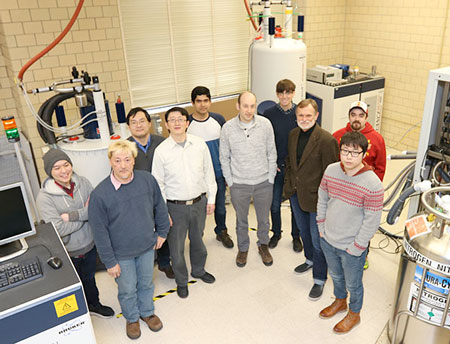| Posted: Feb 19, 2018 |
Seeing the future of new energy materials
(Nanowerk News) How do small defects in the surface of solar cell material affect its ability to absorb and convert sunlight to electricity? How does the molecular structure of a porous material determine its ability to separate gases from one another? Understanding the structure and function of materials at the atomic scale is one of the frontiers of energy science.
|
|
“Many new materials have been developed in the past decade to address needs for energy conversion and storage,” said Aaron Rossini, a scientist at the U.S. Department of Energy’s Ames Laboratory, and a professor of chemistry at Iowa State University. “However, there is still a lot we don’t know about how these materials function. We want to change that and bring new information to the table that will be used to optimize these materials.”
|
 |
| (l-r) Jason Goh, Takeshi Kobayashi, Linlin Wang, Wenyu Huang, Amrit Venkatesh, Aaron Rossini, Frederic Perras, Marek Pruski, Mike Hanrahan and Zhuoran Wang. (Image: Ames Laboratory)
|
|
Ames Laboratory has recently received new funding to study such materials by developing and applying new techniques in solid-state nuclear magnetic resonance (NMR) spectroscopy. “NMR has a long and distinguished history at Ames Laboratory, in terms of both expertise and facilities, and this new research project is its latest chapter,” said Ames Laboratory scientist Marek Pruski, “Understanding the structure of materials is fundamentally important to many research groups here, and we will be collaborating with them at a new level to expand their insights.”
|
|
Most people associate NMR with magnetic resonance imaging (MRI), which is used as a diagnostic tool in medicine. Nuclear magnetic resonance probes the nuclei of atoms as they absorb and re-emit radio waves when they are placed in a magnetic field. Those nuclei resonate at measurable radio-frequencies that precisely depend on the local structure of material, the element being studied, and the strength of the magnetic field.
|
|
In late 2014, the spectroscopy experts at Ames Laboratory took their NMR capabilities a quantum leap forward with the acquisition of the first commercial DNP-NMR spectrometer used for materials research in North America. “DNP” stands for “Dynamic Nuclear Polarization,” a method which uses microwaves to excite unpaired electrons in radicals and transfer their high spin polarization to the nuclei in the sample being analyzed. It’s an ‘extra-oomph’ version of conventional NMR technology, offering drastically higher sensitivity and faster data acquisition—and it has already provided game-changing insight into the physical, chemical, and electronic properties of materials. For example, with DNP-enhanced NMR it is possible to measure the distances in between atoms with precision of a trillionth of a meter or measure two-dimensional correlation spectra between rare nuclei, such as carbon-13.
|
|
“We‘ve had a ball here for the last two and a half years, publishing research findings at the rate of a journal paper per month since the DNP-NMR became operational,” said Pruski. “That’s really a very high pace for high-impact science.”
|
|
“It’s a perfect tool for this type of investigations. The properties of energy materials are governed by the structure of their surfaces and the interfaces, and DNP-NMR is especially well-adapted and sensitive to exploring these.”
|
|
Ames Laboratory will pair these rapidly expanding capabilities in DNP-NMR with a technique called ultrafast magic-angle spinning (UFMAS), which relies on spinning the sample at extremely high frequencies (> 6 million RPM). UFMAS greatly improves NMR experiments by allowing signals from hydrogen to be well resolved in most solids.
|
|
Theoretical physicists will be joining the efforts of the experimentalists, developing models that computationally verify or explain their results. Conversely, NMR experiments will guide the development of improved theoretical models.
|
|
“Our work could have far-reaching impact on a lot of fields, in electronics, lighting, solar cells, nanoparticle design, materials with a variety of energy applications,” said Rossini. “If we are able to explain how structure and function are related, we can help direct intelligent materials design.”
|

